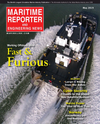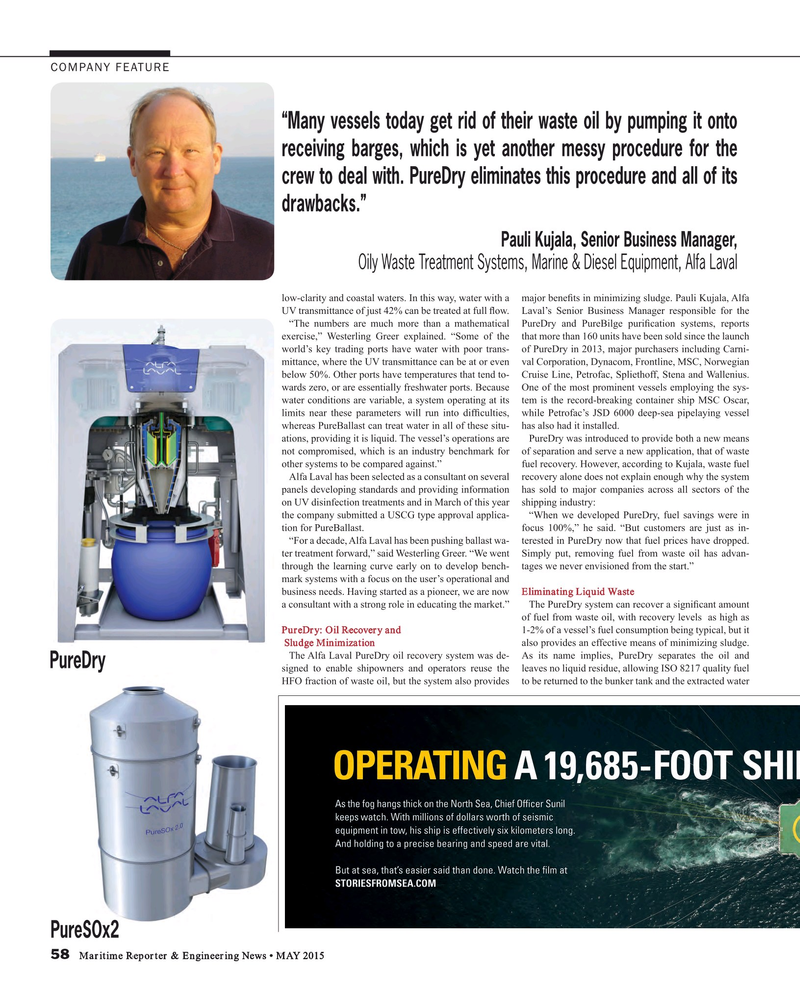
Page 58: of Maritime Reporter Magazine (May 2015)
The Marine Propulsion Edition
Read this page in Pdf, Flash or Html5 edition of May 2015 Maritime Reporter Magazine
COMPANY FEATURE “Many vessels today get rid of their waste oil by pumping it onto receiving barges, which is yet another messy procedure for the crew to deal with. PureDry eliminates this procedure and all of its drawbacks.”
Pauli Kujala, Senior Business Manager,
Oily Waste Treatment Systems, Marine & Diesel Equipment, Alfa Laval low-clarity and coastal waters. In this way, water with a major bene? ts in minimizing sludge. Pauli Kujala, Alfa
UV transmittance of just 42% can be treated at full ? ow. Laval’s Senior Business Manager responsible for the “The numbers are much more than a mathematical PureDry and PureBilge puri? cation systems, reports exercise,” Westerling Greer explained. “Some of the that more than 160 units have been sold since the launch world’s key trading ports have water with poor trans- of PureDry in 2013, major purchasers including Carni- mittance, where the UV transmittance can be at or even val Corporation, Dynacom, Frontline, MSC, Norwegian below 50%. Other ports have temperatures that tend to- Cruise Line, Petrofac, Spliethoff, Stena and Wallenius. wards zero, or are essentially freshwater ports. Because One of the most prominent vessels employing the sys- water conditions are variable, a system operating at its tem is the record-breaking container ship MSC Oscar, limits near these parameters will run into dif? culties, while Petrofac’s JSD 6000 deep-sea pipelaying vessel whereas PureBallast can treat water in all of these situ- has also had it installed.
ations, providing it is liquid. The vessel’s operations are PureDry was introduced to provide both a new means not compromised, which is an industry benchmark for of separation and serve a new application, that of waste other systems to be compared against.” fuel recovery. However, according to Kujala, waste fuel
Alfa Laval has been selected as a consultant on several recovery alone does not explain enough why the system panels developing standards and providing information has sold to major companies across all sectors of the on UV disinfection treatments and in March of this year shipping industry: the company submitted a USCG type approval applica- “When we developed PureDry, fuel savings were in tion for PureBallast. focus 100%,” he said. “But customers are just as in- “For a decade, Alfa Laval has been pushing ballast wa- terested in PureDry now that fuel prices have dropped. ter treatment forward,” said Westerling Greer. “We went Simply put, removing fuel from waste oil has advan- through the learning curve early on to develop bench- tages we never envisioned from the start.” mark systems with a focus on the user’s operational and business needs. Having started as a pioneer, we are now Eliminating Liquid Waste a consultant with a strong role in educating the market.” The PureDry system can recover a signi? cant amount of fuel from waste oil, with recovery levels as high as
PureDry: Oil Recovery and 1-2% of a vessel’s fuel consumption being typical, but it Sludge Minimization also provides an effective means of minimizing sludge.
The Alfa Laval PureDry oil recovery system was de- As its name implies, PureDry separates the oil and
PureDry signed to enable shipowners and operators reuse the leaves no liquid residue, allowing ISO 8217 quality fuel
HFO fraction of waste oil, but the system also provides to be returned to the bunker tank and the extracted water
PureSOx2 58 Maritime Reporter & Engineering News • MAY 2015
MR #5 (58-65).indd 58 MR #5 (58-65).indd 58 5/8/2015 9:41:27 AM5/8/2015 9:41:27 AM

 57
57

 59
59
